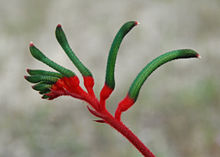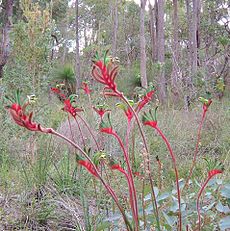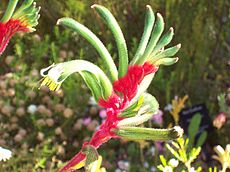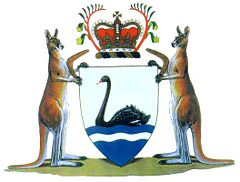- Anigozanthos manglesii
-
Anigozanthos manglesii Anigozanthos manglesii Scientific classification Kingdom: Plantae (unranked): Angiosperms (unranked): Monocots (unranked): Commelinids Order: Commelinales Family: Haemodoraceae Subfamily: Conostyloideae Genus: Anigozanthos Species: A. manglesii Binomial name Anigozanthos manglesii
D.DonAnigozanthos manglesii, commonly known as the Red and Green Kangaroo Paw or Mangles Kangaroo Paw, is a plant species endemic to Western Australia, and the floral emblem of that state.
The most admired of the Kangaroo paw species, the flower has become symbolic of the region. The display between August and November is remarkable for the high standing flowers, occurring in urban and coastal regions. The species is not threatened, but is protected under state legislation. A license is required for their collection. It is desirable as a cut flower, possessing an unusual form and striking colours that last well.
Contents
Description
Anigozanthos manglesii is a rhizotomous perennial which has long, grey-green linear leaves around 30 to 60 cm long. A member of the Anigozanthos genus, it is less than a shrub in its form. The leaves are grey-green and extend from a central point at ground level, giving the form of its base. Its red and green flowers appear at the end of long stalks between August and November. The flowers display in a sequence from the lowest point, those following are in a progression of development. The spent flower-stalks may remain well after their season. The length of these stalks from the base is up to 1200 mm tall.
Distribution
The species is widely distributed throughout the Southwest Australian biogeographic regions, preferring white, yellow or grey sand, or sandy loam. The occurrence is confirmed in the northern most part of its range in the Geraldton Sandplains and the Swan Coastal Plain near Perth. Extensive records also exist of occurrence in Jarrah Forest and Warren region to the south, but not reaching the southern coasts. It extends inland to the Avon Wheatbelt.
Taxonomy
The species was first described by English botanist David Don in 1834 from the type specimen:
This singularly beautiful species of Anigozanthos was raised in the garden at Whitmore Lodge, Berks., the seat of Robert Mangles, Esq. from seeds brought from Swan River by Sir James Stirling, the enterprising governor of that colony, by whom they had been presented to Mr. Mangles.There are two recognised subspecies as follows:
- Anigozanthos manglesii subsp. quadrans Hopper
- Distribution of the subspecies is as far north as Shark Bay, variation in habit and structure of the subspecies is otherwise discrete.
- Anigozanthos manglesii D.Don subsp. manglesii
- Wide occurrence as far north as Gingin and to Cape Leeuwin in the south.
Anigozanthos manglesii is known to hybridize naturally with other Anigozanthos species:
- A. viridis – progeny have been named Anigozanthos manglesii var. × angustifolius Lindl. and Anigozanthos manglesii var. × virescens Ostenf.
- A. bicolor
- A. kalbarriensis
- A. humilis
Cultivars
Anigozanthos manglesii is often artificially hybridized with A flavidus and to a lesser extent A. rufus. Cultivars include:
- 'Autumn Mystery' - A. manglesii x A. flavidus
- 'Big Red' - A. manglesii x A. flavidus
- 'Bush Emerald' - A. manglesii x A. flavidus
- 'Hickman’s Delight' - A. manglesii x A. flavidus
- 'Rogue Radiance' - (A. manglesii x A. rufus) x A. flavidus
- 'Space Age' - A manglesii x A. flavidus
- 'Sue Dixon' - (A. manglesii x A. rufus) x A. flavidus
Cultivation
The species germinates readily from seed. As plants generally deteriorate after the second season, they are best treated as a biennial. They are dormant in the summer, and watering should be withheld during this period. They are susceptible to the fungal ink spot disease and the leaves are attractive to snails. They are often used as cut flowers, due to their unique appearance and lasting qualities.
Symbolic and artistic references
In November 1960, Anigozanthos manglesii was adopted as the floral emblem of Western Australia in a proclamation made by then Premier of Western Australia David Brand.[1]
It also appears on the armorial bearings of that state, framing the crown in the Coat of arms. This is given to denote the sovereignty and independence of Western Australia. The blazon reads:And for Crest: On a Wreath Or and Sable The Royal Crown between two Kangaroo Paw (Anigosanthos [sic] Manglesii) flowers slipped proper.
A Red and Green Kangaroo Paw superimposed over a scene of Perth was depicted on a 5 pence on a 1962 Australian stamp issue designed by R. M. Warner to mark the British Empire and Commonwealth Games held in Perth that year[2]. In 1968 another stamp issue, designed by Nell Wilson, showed the Red and green Kangaroo Paw as part of a series on state floral emblems[3].
See also
Further reading
- Hopper, Stephen D.; Babs and Bert Wells ill.. Kangaroo paws and catspaws : a natural history and field guide. Como, W.A. p. 144 p.. ISBN 0730959139.
References
- ^ "The Floral Emblem of Western Australia". Department of the Premier and Cabinet. Perth, WA: Government of Western Australia. 8 July 2008. http://www.dpc.wa.gov.au/SymbolsofWA/Pages/FloralEmblem-RedandGreenKangarooPaw.aspx. Retrieved 28 March 2010.
- ^ Stamp image
- ^ Stamp image
- "Anigozanthos manglesii". FloraBase. Department of Environment and Conservation, Government of Western Australia. http://florabase.dec.wa.gov.au/browse/profile/1411.
- "Anigozanthos manglesii D. Don". Australian Plant Name Index (APNI), IBIS database. Centre for Plant Biodiversity Research, Australian Government. http://www.anbg.gov.au/cgi-bin/apni?taxon_id=38418.
- "Anigozanthos manglesii". The Kangaroo Paw Family. ASGAP. 2004-06-04. http://asgap.org.au/a-man.html. Retrieved 2007-08-02. "The plant is susceptible to fungal disease such as "ink spot", which is first seen as small black spots on the foliage which gradually spread and kill the plant."
- Anne Boden (2006-10-11). "Red and Green Kangaroo Paw. 'Anigozanthos manglesii". Emblems. Australian National Botanic Gardens (ANBG). http://www.anbg.gov.au/emblems/wa.emblem.html. Retrieved 2007-08-02.
- Extract from Government Gazette (No.95) of 18 November 1960. PROCLAMATION:
By His Excelency The Honourable Sir John Patric Dwyer, ... Liutenant-Governor (Lieutenant Governor) in and over the State of Western Australia and its Dependencies in the Commonwealth of Australia. ...desirable that a floral emblem be adopted as an emblem of the State ... described as Anigosanthos Manglesii D. Don: NOW THEREFORE I, the Liutenant-Governor, ... Given under my hand and the Public Seal of the said State at Perth, this 9th day of November, 1960. By His Excellency's Command, DAVID BRAND, PREMIER. GOD SAVE THE QUEEN !!! (abbreviated and uncorrected text from ANGB)
External links
- Australian Cultivar Registration Authority (ACRA) - List for genus Anigozanthos , updates the cultivar epithets.
Floral emblems of Australia and its states and territories National: Acacia pycnantha (Golden Wattle)
ACT Wahlenbergia gloriosa (Royal Bluebell) • NSW Telopea speciosissima (New South Wales Waratah) • NT Gossypium sturtianum (Sturt's Desert Rose)
QLD Dendrobium phalaenopsis (Cooktown Orchid) • SA Swainsona formosa (Sturt's Desert Pea) • TAS Eucalyptus globulus (Tasmanian Blue Gum)
VIC Epacris impressa (Common Heath) • WA Anigozanthos manglesii (Red and Green Kangaroo Paw)Categories:- Commelinales of Australia
- Angiosperms of Western Australia
- Haemodoraceae
- National symbols of Australia
- Garden plants
Wikimedia Foundation. 2010.





